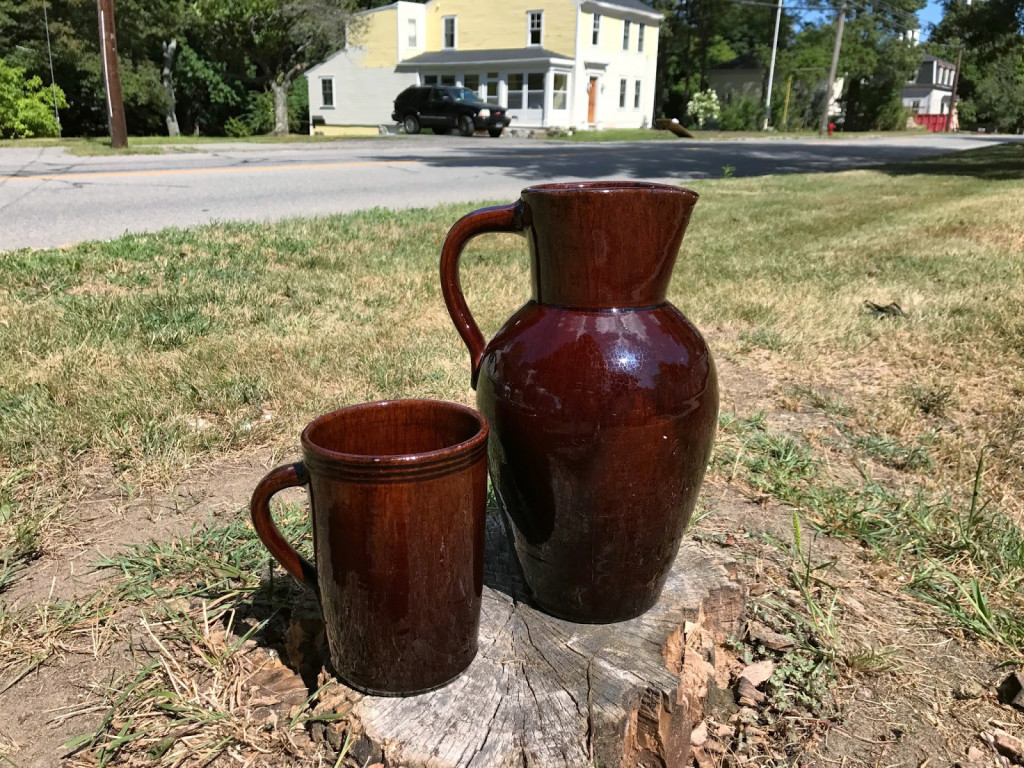Those who bemoan the lack of “young blood” in the antiques field will be pleased to know Justin Thomas, whose energetic interest in early American pottery puts to shame all but the most seasoned academician. Thomas’ parents had a passion for restoring and decorating homes with period-appropriate furnishings, and he first fell in love with American ceramics in 1999, when his father brought home a black glazed Essex County redware jug found at a local flea market. The morning editor for CBS Boston’s weekday morning show, Thomas spends his off hours poking around auctions, antiques shows and flea markets, often with his niece, Alexis, looking for examples of underappreciated or misidentified American ceramics. He also writes a blog — www.earlyamericanceramics — that tracks his research and where he posts field photographs of finds. Antiques and The Arts Weekly went on the trail with this inveterate ceramics historian and “sherd whisperer” to learn more about one of his current obsessions, the Moses Paige Pottery.
When did Paige Pottery begin and when was its heyday?
Moses Paige (1847/48–1941) purchased the old Osborn pottery company in Peabody, Mass., from Joseph Reed in 1876. The company continued to manufacture household red earthenware as the previous owners had managed it; however, production clearly began to change in the 1880s and 1890s. Throughout this period, Paige was expanding the pottery’s facilities to maximize production. The heyday of this business must have taken place during the circa 1876–1930 period, when Paige continued to build upon the company’s reputation and increased production.
Who were some of Paige Pottery’s primary competitors?
The primary competitors would have been other local manufacturers, including Charles A. Lawrence’s pottery, in nearby Beverly, Mass., which existed from the 1860s until about 1906. There was probably also some competition from the Robertson family of potters in Chelsea, Mass. Essentially though, Paige created somewhat of a monopoly in the Twentieth Century, keeping with traditional production, and also adapting the business to meet modern demands.
How did Paige Pottery measure up against these contemporaries, both in terms of quality of product and price?
Surviving production from the Paige Pottery is often misinterpreted for production dating back to the early 1800s. From the pots I have handled, the wares were manufactured the same way, as the Osborn family, the Reed Pottery and many other companies throughout New England, would have made them. Prices must have been competitive as well.
What are some identifying characteristics of Paige Pottery?
In terms of the Paige Pottery, it’s still a learning process since production was so broad, and a lot has not been documented. First and foremost, it’s all about the form and the way it was made; the glaze is completely secondary. I look for matching forms from known styles, but not necessarily the same glaze color. Another characteristic I have noticed about some of the wares made at the Paige Pottery is that a fluid or thick glaze sometimes accumulates into drips on the base, forcing the object to stand uneven after it has been fired in the kiln. The Paige Pottery often ground this base glaze, so the object would stand even, a characteristic regularly found with art pottery made in Massachusetts. It’s really unusual to see this with more traditional red earthenware potters.

Late Nineteenth or early Twentieth Century red earthenware mug and pitcher attributed to John Donovan’s production at the Paige Pottery in Peabody, Mass. Photo courtesy: Justin W. Thomas.
What were its most popular forms?
Their most popular forms of Paige Pottery’s production, for at least an extended period, pertained to flowerpots, simple pots and crocks, animal feeders and drainpipes. As the business grew, the company began to produce some more decorative styles like vases. During the 1895–1900 period, a potter named James Porter made large vases with heavily applied decorations, like flowers.
Are there institutions or collections of Paige Pottery that readers or collectors can look to for additional information?
The National Museum of American History in Washington, DC, the MFA Boston and Old Sturbridge Village have excellent examples. However, the best resource is the Peabody Historical Society, which is really a time capsule since they established a working relationship with Paige Pottery when the organization was founded in 1896. It owns some wonderful examples acquired brand new from Paige Pottery, like a brilliant green glazed vase, cups and saucers and flowerpots. They own actual ingredients used in the glazing process given to the museum in 1909 by Paige, as well as a large original painted sign. But in my opinion, the most important aspect in the collection, related to the Paige Pottery, is a remarkable selection of archival photos, which puts actual faces to the names and demonstrates the life of the pottery.
What is it about early American ceramics that excites you?
I’ve always enjoyed writing and the combination of the history of American ceramics seemed like the perfect marriage. My excitement revolves around the hunt for tangible and intangible information, and the fact that the current history about some pottery production in America is regularly rewritten today. It’s a fascinating search trying to find objects, artifacts and information, and how this is all put together in the big picture today. I think Paige Pottery is an exciting company, and it really provides an opportunity to find wares today from a skilled business that is not currently widely known, which I hope in time will grow to be a regular name in the field of American pottery and antiques. I’ve recently posted a lot more information and photos about Paige Pottery on my blog — check it out!
—Madelia Hickman Ring





